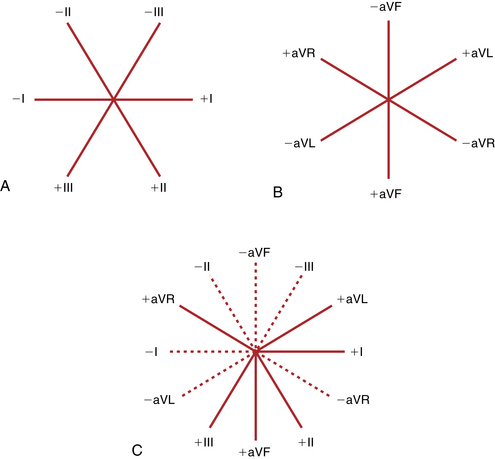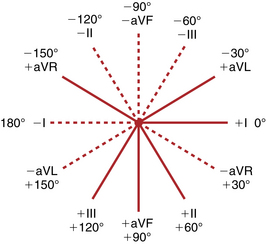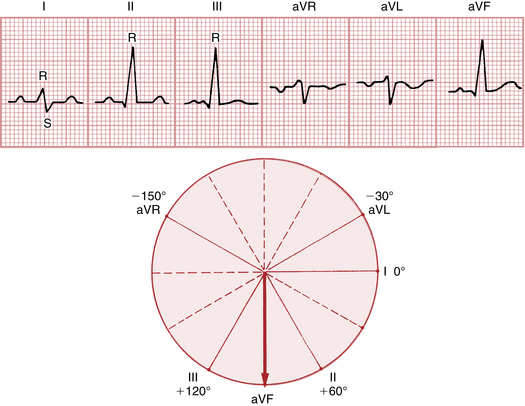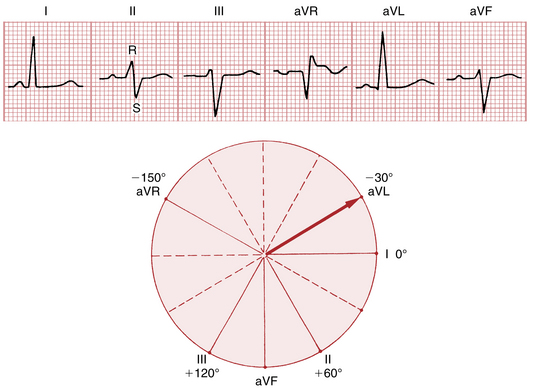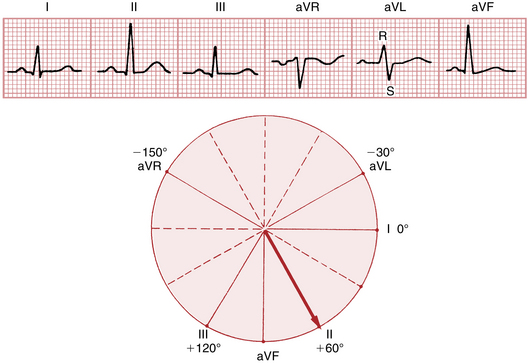Chapter 5 Electrical Axis and Axis Deviation
Please go to expertconsult.com for supplemental chapter material.
Normal ECG patterns in the chest and extremity leads were discussed in Chapter 4. The general terms horizontal heart (or horizontal QRS axis) and vertical heart (or vertical QRS axis) were used to describe the normal variations in QRS patterns seen in the extremity leads. In this chapter the concept of electrical axis is refined, and methods are presented for estimating the QRS axis quickly and simply.
Mean QRS Axis: Definition
Because the QRS axis is being defined in the frontal plane, the QRS is being described only in reference to the six extremity leads (the six frontal plane leads). Therefore, the scale of reference used to measure the mean QRS axis is the diagram of the frontal plane leads (described in Chapter 3 and depicted again in Fig. 5-1). Einthoven’s triangle can easily be converted into a triaxial lead diagram by having the axes of the three standard limb leads (I, II, and III) intersect at a central point (Fig. 5-1A). Similarly the axes of the three augmented limb leads (aVR, aVL, and aVF) also form a triaxial lead diagram (Fig. 5-1B). These two triaxial lead diagrams can be combined to produce a hexaxial lead diagram (Fig. 5-1C). You will be using this diagram to determine the mean QRS axis and describe axis deviation.
As noted in Chapter 3, each lead has a positive and negative pole (see Fig. 5-1C). As a wave of depolarization spreads toward the positive pole, an upward (positive) deflection occurs. As a wave spreads toward the negative pole, a downward (negative) deflection is inscribed.
Finally, a scale is needed to determine or calculate the mean QRS axis. By convention the positive pole of lead I is said to be at 0°. All points below the lead I axis are positive, and all points above that axis are negative (Fig. 5-2). Thus, toward the positive pole of lead aVL (–30°), the scale becomes negative. Downward toward the positive poles of leads II, III, and aVF, the scale becomes more positive (lead II at +60°, lead aVF at +90°, and lead III at +120°).
The completed hexaxial diagram used to measure the QRS axis is shown in Figure 5-2. By convention again, an electrical axis that points toward lead aVL is termed leftward or horizontal. An axis that points toward leads II, III, and aVF is rightward or vertical.
Mean QRS Axis: Calculation
In calculating the mean QRS axis, you are answering this question: In what general direction or toward which lead axis is the QRS complex predominantly oriented? In Figure 5-3, for example, notice the tall R waves in leads II, III, and aVF. These waves indicate that the heart is electrically vertical (vertical electrical axis). Furthermore, the R waves are equally tall in leads II and III.∗ Therefore, by simple inspection the mean electrical QRS axis can be seen to be directed between the positive poles of leads II and III and toward the positive pole of lead aVF (+90°).
As a general rule, the mean QRS axis points midway between any two leads that show tall R waves of equal height.
In Figure 5-3 the mean electrical axis could have been calculated a second way. Recall from Chapter 3 that if a wave of depolarization is oriented at right angles to any lead axis, a biphasic complex (RS or QR) is recorded in that lead. Reasoning in a reverse manner, if you find a biphasic complex in any of the extremity leads, the mean QRS axis must be directed at 90° to that lead. Now look at Figure 5-3 again. Do you see any biphasic QRS complexes? Obviously, lead I is biphasic and shows an RS pattern. Therefore, the mean electrical axis must be directed at right angles to lead I. Because lead I on the hexaxial lead scale is at 0°, the mean electrical axis must be at right angles to 0° or at either –90° or +90°. If the axis were –90°, the depolarization forces would be oriented away from the positive pole of lead aVF and that lead would show a negative complex. In Figure 5-3, however, lead aVF shows a positive complex (tall R wave); therefore the axis must be +90°.
Figure 5-4 presents another example. By inspection the mean QRS axis is obviously horizontal, because leads I and aVL are positive and leads II, III, and aVF are predominantly negative. The precise electrical axis can be calculated by looking at lead II, which shows a biphasic RS complex. Therefore the axis must be at right angles to lead II. Because lead II is at +60° on the hexaxial scale (see Fig. 5-2), the axis must be either –30° or +150°. If it were +150°, leads II, III, and aVF would be positive. Clearly the axis is –30°.
Another example is given in Figure 5-5. The QRS complex is positive in leads II, III, and aVF. Therefore the axis is relatively vertical. Because the R waves are of equal magnitude in leads I and III, the mean QRS axis must be oriented between these two leads, or at +60°.
Alternatively, in Figure 5-5 the QRS axis can be calculated by looking at lead aVL, which shows a biphasic RS-type complex. The axis must be at right angles to lead aVL (–30°); that is, it must be oriented at either –120° or +60°. Obviously, the axis is at +60°, since the electrical axis must be oriented toward lead II, which shows a relatively tall R wave.
Stay updated, free articles. Join our Telegram channel

Full access? Get Clinical Tree


